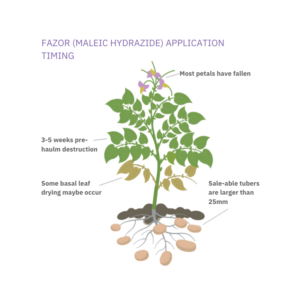Guidance launched to maximise the value of maleic hydrazide in potato crops
27th June 2023
Crop protection manufacturer UPL has reminded potato growers of the importance of maleic hydrazide in sprout control and has issued best practice guidance to maximise its effect this season.

Jonathan Kemp of Mercian Ltd believes a potato sprout control programme should start with an in-crop application of Fazor.
Maleic hydrazide is found in the potato plant growth regulator (PGR) Fazor and is crucial in potato sprout control programmes, the company claims.
Jonathan Kemp of Mercian Ltd, which is a UK supplier of potatoes to the crisping industry, believes that a grower’s potato sprout control programme should begin with an in-crop application of Fazor.
“The most important application for potato storage is Fazor. If Fazor is unused, growers can find it difficult to manage their crop storage,” Jonathan warns.
To help maximise the value of maleic hydrazide this season, UPL has issued guidance to potato growers. Geoff Hailstone, UPL’s potato technical expert, claims maleic hydrazide is used by 90% of growers in the industry
“It has become essential to start a sprout control programme, and because it is applied to the crop, it is the most cost-effective method.
“Typically, the first application of Argos (orange oil) will not be necessary until two to three months after storage if the crop has had an application of Fazor,” he says.
“Without this, an application of Argos might be needed within two to six weeks, or even sooner following a hot growth season. In addition, crops treated with Fazor have a lower risk of secondary growth, reduced internal sprouting in store, and it significantly reduces volunteer potatoes in the following crops.”
Like all PGRs, timing the application for the correct growth stage is crucial. It is important that maleic hydrazide is properly absorbed and translocated to the growth points of the tubers.
Mr Hailstone advises that Fazor should be applied when the saleable tubers are larger than 25mm, at the first signs of the lowest leaves senescing, when some flowers are still present but most have fallen, and three to five weeks before haulm destruction.
“Getting the correct timing can be tricky, especially when growers are juggling blight spray programmes and irrigation, but growers must prioritise Fazor because they only have one opportunity to get it right,” he notes.
“In particular, the tuber size must be correct because if Fazor is applied too early, it may prevent tuber development and cause loss of yield. This is because maleic hydrazide stops cell division but not cell expansion. Once tubers have reached 25mm in size, the cell division is complete, and there is no negative effect on the yield.”
“When it comes to application, Fazor should not be tank mixed with any other products. It should not be applied less than 24 hours before irrigation or rainfall, and only in the evening if the daytime temperatures exceed 25C. I would recommend a water volume between 350 and 550 litres per hectare to get the optimum crop coverage.
“Where ideal application conditions are not possible there is still very valuable sprout suppression from maleic hydrazide levels of three or four parts per million, but if growers are able to follow this guidance, then they will have achieved a significant milestone in ensuring their potato crop has the best possible marketable quality,” Mr Hailstone concludes.

